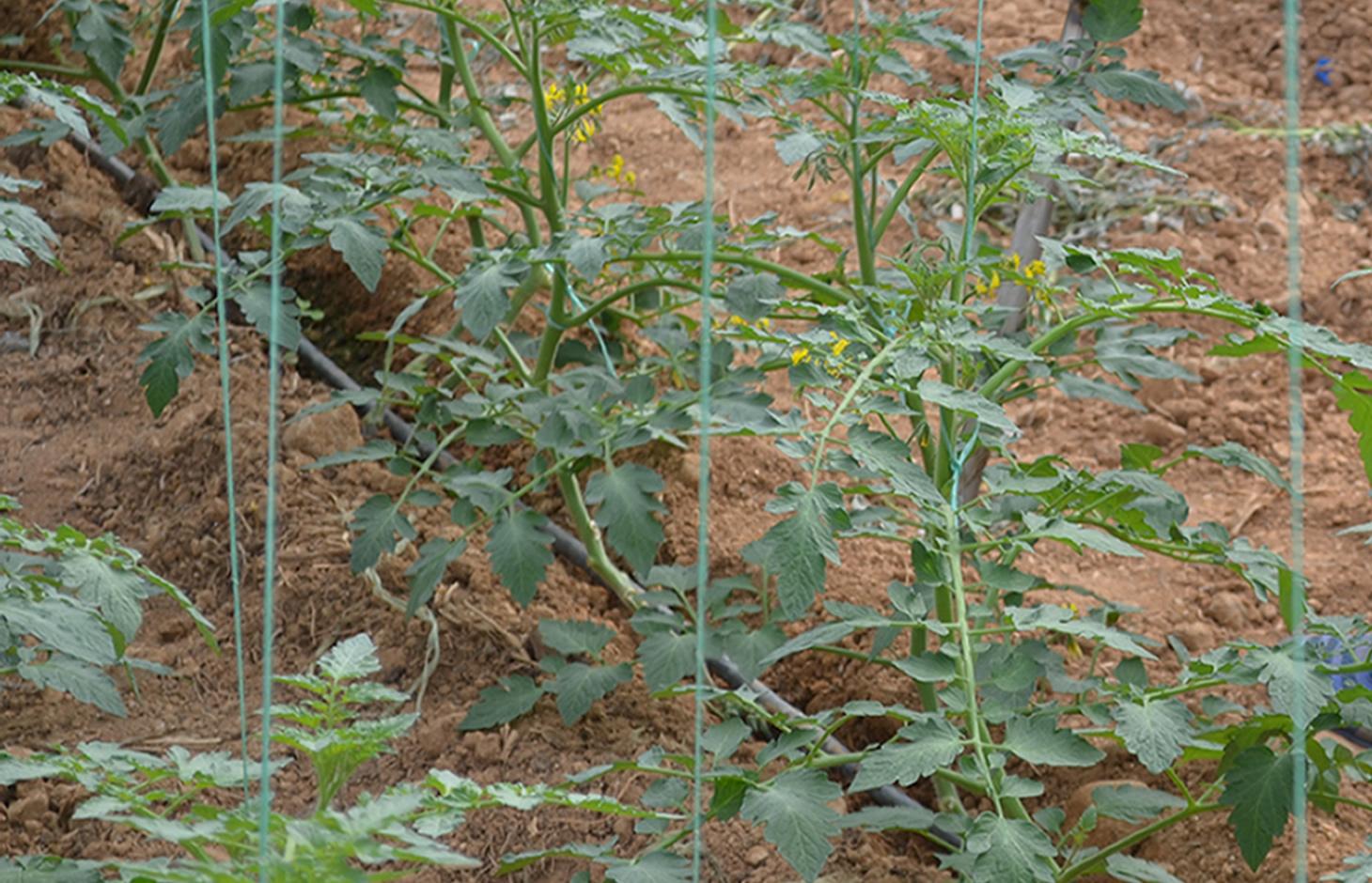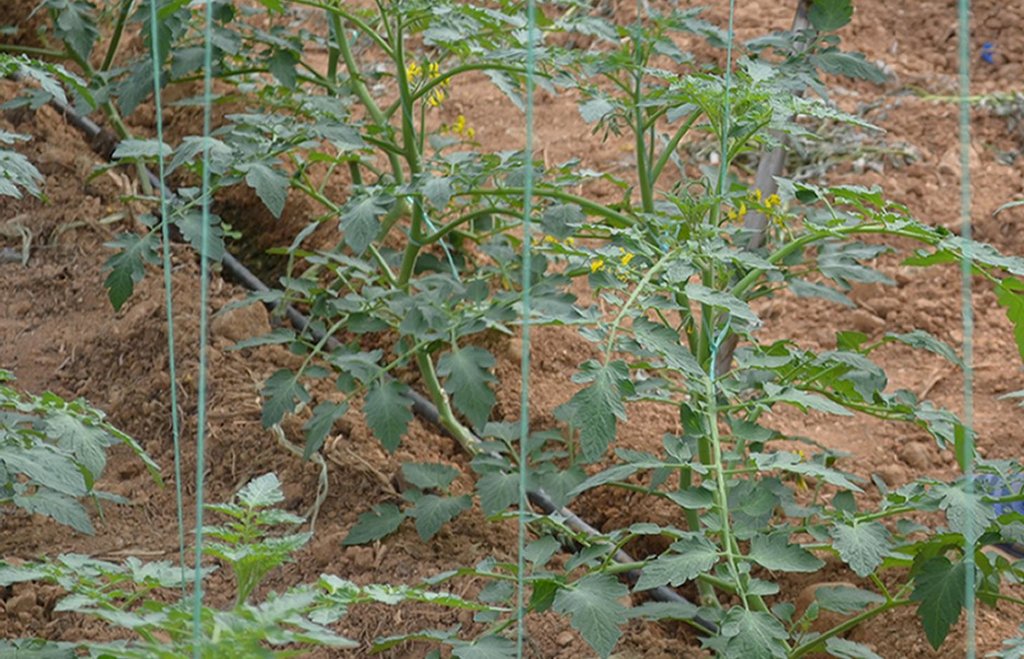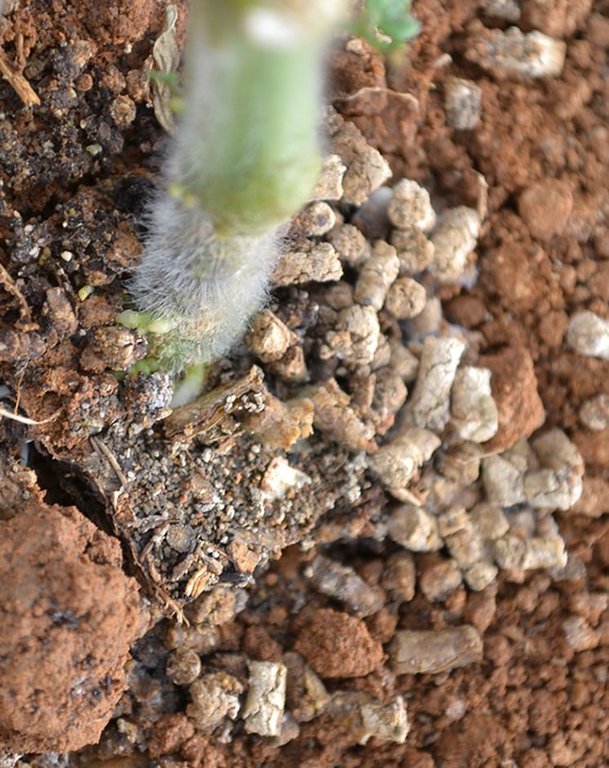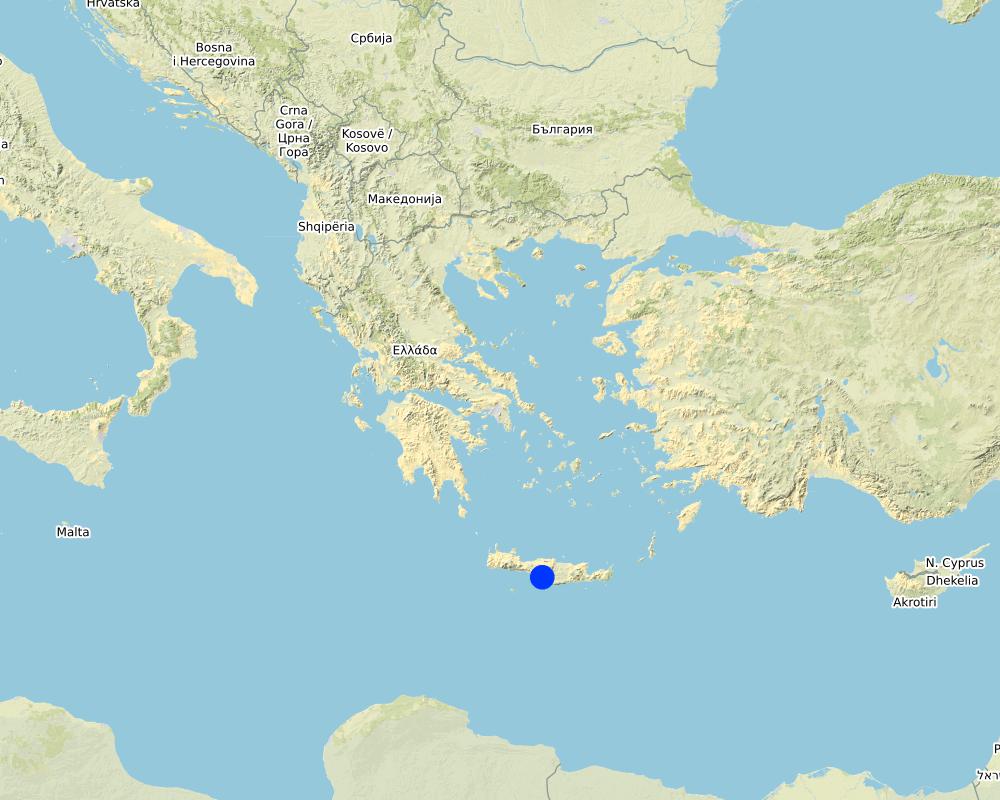Application of biological agents to increase crop resistance to salinity [اليونان]
- تاريخ الإنشاء:
- تحديث:
- جامع المعلومات: Ioanna Panagea
- المحرر: –
- المراجعون: Alexandra Gavilano, Fabian Ottiger, Rima Mekdaschi Studer
Εφαρμογή βιολογικών παραγόντων για την αύξηση της αντοχής των φυτών στην αλατότητα του εδάφους
technologies_1281 - اليونان
عرض الأقسام
توسيع الكل طي الكل1. معلومات عامة
1.2 تفاصيل الاتصال بالأشخاص الرئيسيين لمصدر المعلومات والمؤسسات المشاركة في تقييم وتوثيق التقنية
متخصص في الإدارة المستدامة للأراضي:
متخصص في الإدارة المستدامة للأراضي:
اسم المشروع الذي سهّل توثيق/تقييم التقنية (إذا كان ذلك على صلة)
Preventing and Remediating degradation of soils in Europe through Land Care (EU-RECARE )اسم المؤسسة (المؤسسات) التي سهلت توثيق/تقييم التقنية (إذا كان ذلك على صلة)
Technical University of Crete (Technical University of Crete) - اليونان1.3 الشروط المتعلقة باستخدام البيانات الموثقة من خلال WOCAT
يوافق جامع المعلومات والشخص (لاشخاص) الرئيسي لمصدر المعلومات على الشروط المتعلقة باستخدام البيانات الموثقة من خلال WOCAT:
نعم
2. وصف تقنيةالإدارة المستدامي للأراضي
2.1 وصف مختصر للتقنية
تعريف التقنية:
Use of biological agents as plant salt tolerance facilitators and soil amendments.
2.2 وصف تفصيلي للتقنية
الوصف:
The Trichoderma harzianum fungus and different various types of symbiotic associations of mycorrhizae are used in greenhouse cultivations in coastal Timpaki, Crete, Greece, in order to mitigate the impacts of salinity on crops and to improve the existing soil properties. These biological agents are supplied commercially as soil amendments, and specific treatments vary according to cultivation type.
Purpose of the Technology: The technology is applied as an effective agronomic measure for the increase of plants salt tolerance, the reduction of soil borne diseases that affect plant roots and increase of water and nutrients absorption. This technology prevents or mitigates soil degradation by improving the subsoil structure by causing plant root system expansion and increasing the ability of the plant to absorb nutrients and water. This effect can potentially decrease agricultural inputs (water and fertilizers) up to 40%. An additional benefit is the maintenance and increase of subsoil faunal diversity and the subsequent biodegradation. The improved soil structure leads to higher infiltration rates, mitigates salt accumulation in the root zone and combats soil salinity, one of the main soil degradation problems in the coastal zone. Finally, the application of the biological agent helps to keep the plants healthy thus leading to increased crop yield, and reduced production risk.
Establishment / maintenance activities and inputs: The implementation of such agents usually takes place once per plant as the microorganisms coexist with the plant (symbiotic association) and can be performed in different stages of the crop cultivation depending on the commercial product, e.g. as solution in the irrigation water, as solid soil amendment in the early growing stages, or optimally, to be applied in the plant nursery (seed bio-priming), or during planting (plant inoculation). Biological agents require increased organic matter in the soil, absence of toxic substances (e.g. copper, fungicides, and pesticides), and, depending on agent type, suitable soil moisture and temperature. Here we instigate the effects of biological agents in tomato plantations, which are implemented in the early growing stages through irrigation.
Natural / human environment: The average annual precipitation in the area is 500 mm and the climate ranges between sub-humid Mediterranean and semi-arid. Average annual temperature is 18.5 °C with 6 months below 18 °C but above 5 °C, thus classifying the area as subtropical. In the location where the technology is applied, land is mostly privately owned and water rights can be public, cooperative or private. The financial means of the land user applying this technology are more or less on par with those of the rest of the community, although he has wider empirical and theoretical education and higher impact acquired though his involvement in the local agricultural association as agronomist.
This Technology was documented within the scope of FP7 RECARE Project, grant agreement no 603498.
2.3 صور التقنية
2.5 البلد/المنطقة/المواقع التي تم تنفيذ التقنية فيها والتي يغطيها هذا التقييم
البلد:
اليونان
المنطقة/الولاية/المحافظة:
Heraklion
مزيد من التفاصيل حول الموقع:
Timpaki
حدد انتشار التقنية:
- يتم تطبيقها في نقاط محددة/ تتركز على مساحة صغيرة
هل يقع موقع/مواقع التقنية في منطقة محمية بشكل دائم؟:
كلا
التعليقات:
Total area covered by the SLM Technology is 0.002 km2.
Map
×2.6 تاريخ التنفيذ
في حالة عدم معرفة السنة بالتحديد، يرجى الإشارة إلى التاريخ التقريبي:
- منذ 10-50 سنة
2.7 إدخال التقنية
حدد كيف تم إدخال التقنية:
- من خلال ابتكار مستخدمي الأراضي
التعليقات (نوع المشروع، الخ):
The use of biological agents in agriculture is not new but it is also not part of the traditional cultivation system in the area, therefore the technology is not widely used.
3. تصنيف تقنية الإدارة المستدامي للأراضي
3.2 نوع (أنواع) استخدام الأراضي الحالية حيث يتم تطبيق التقنية

الأراضي الزراعية
- زراعة سنوية
- tomatoes
عدد مواسم الزراعة في السنة:
- 1
حدد:
Longest growing period in days: 300Longest growing period from month to month: September to June
التعليقات:
Major land use problems (compiler’s opinion): The main problem in the region is the change in the groundwater quality, caused by the groundwater exploitation and and the subsequent seawater intrusion, resulting in soil salinisation through irrigation. The poor availability of non-saline water for irrigation results in increased production risk and agricultural inputs.
Major land use problems (land users’ perception): Reduced soil fertility and productivity, increase of soil salinity that affects productivity both short-term and long-term.
3.4 إمدادات المياه
إمدادات المياه للأرض التي يتم تنفيذ التقنية عليها:
- ري كامل
3.5 مجموعةالإدارة المستدامة للأراضي التي تنتمي إليها هذه التقنية
- الإدارة المتكاملة للآفات والأمراض (بما في ذلك الزراعة العضوية)
- soil amendments
3.6 التدابير التقنية في مجال إلادارة المستدامة للأراضي

التدابير الزراعية
- A2: المادة العضوية/خصوبة التربة
- A4: المعالجة تحت السطحية
التعليقات:
Main measures: agronomic measures
3.7 الأنواع الرئيسية من تدهور الأراضي التي تناولتها التقنية

التدهور الكيميائي للتربة
- (Cn): تراجع الخصوبة وانخفاض محتوى المادة العضوية (غير ناتج عن الانجراف)
- (Cs): التملح/ القلونة

التدهور المادي أو الفيزيائي للتربة
- (Pu): فقدان الوظيفة الإنتاجية الحيوية بسبب أنشطة أخرى

التدهور البيولوجي
- (Bq): انخفاض الكمية/الكتلة الحيوية
التعليقات:
Main type of degradation addressed: Pu: loss of bio-productive function due to other activities, Bq: quantity / biomass decline
Secondary types of degradation addressed: Cn: fertility decline and reduced organic matter content, Cs: salinisation / alkalinisation
Main causes of degradation: soil management (Intensive cultivation), over abstraction / excessive withdrawal of water (for irrigation, industry, etc.) (Over-pumping), inputs and infrastructure: (roads, markets, distribution of water points, other, …) (Poor coverage of freshwater irrigation network.)
Secondary causes of degradation: crop management (annual, perennial, tree/shrub) (Monocultivation), droughts (Lack of sustainable water resources.)
3.8 منع أو حد أو عكس تدهور الأراضي
تحديد هدف التقنية فيما يتعلق بتدهور الأراضي:
- منع تدهور الأراضي
- الحد من تدهور الأراضي
التعليقات:
Main goals: prevention of land degradation
Secondary goals: mitigation / reduction of land degradation
4. المواصفات الفنية، وأنشطة التنفيذ، والمدخلات، والتكاليف
4.1 الرسم الفني للتقنية
المواصفات الفنية (المتعلقة بالرسم الفني):
Technical knowledge required for field staff / advisors: high
Technical knowledge required for land users: low
Main technical functions: improvement of subsoil structure (hardpan), increase in nutrient availability (supply, recycling,…), increase of water and nutrients absorption rate by plants, plant root system expansion
Secondary technical functions: increase of infiltration
Agronomic measure: use of biological agents
Material/ species: Trichoderma harzianum or Mycorrhizae
Remarks: 25 gr/10 lt water is enough for 10 tomato plants
4.2 معلومات عامة بخصوص حساب المدخلات والتكاليف
عملة أخرى/ عملة وطنية (حدد):
Euro
إذا كان ذا صلة، وضح سعر الصرف من الدولار الأمريكي إلى العملة المحلية (على سبيل المثال، 1 دولار أمريكي = 79.9 ريال برازيلي): 1 دولار أمريكي =:
0,91
4.3 أنشطة التأسيس
| النشاط | التوقيت (الموسم) | |
|---|---|---|
| 1. | biological agents in the form of powder and implementation through irrigation in each growing season | in each growing season |
4.4 التكاليف والمدخلات اللازمة للتأسيس
| تحديد المدخلات | الوحدة | الكمية | التكاليف لكل وحدة | إجمالي التكاليف لكل مدخل | % من التكاليف التي يتحملها مستخدمو الأراضي | |
|---|---|---|---|---|---|---|
| الأسمدة والمبيدات الحيوية | Biological agents (powder) | ha | 1,0 | 3232,0 | 3232,0 | 100,0 |
| إجمالي تكاليف إنشاء التقنية | 3232,0 | |||||
| إجمالي تكاليف إنشاء التقنية بالدولار الأمريكي | 3551,65 | |||||
4.7 أهم العوامل المؤثرة على التكاليف
قدم وصفا لأهم العوامل التي تؤثر على التكاليف:
The only cost is the supply of the formulation with the biological agents which should be done before each growing season.
5. البيئة الطبيعية والبشرية
5.1 المناخ
هطول الأمطار السنوي
- < 250 مم
- 251- 500 ملم
- 501 - 750ملم
- 1,000-751 ملم
- 1,500-1,100 ملم
- 2,000-1,500 ملم
- 3,000-2,001 ملم
- 4,000-3,100 ملم
- > 4000 ملم
المنطقة المناخية الزراعية
- شبه رطبة
- شبه قاحلة
Thermal climate class: subtropics. 6 months below 18 °C but above 5 °C
5.2 طوبوغرافيا
متوسط الانحدارات:
- مسطح (0-2%)
- بسيط (3-5%)
- معتدل (6-10%)
- متدحرج (11-15%)
- تلال (16-30%)
- شديدة الانحدار(31-60%)
- فائقة الانحدار (>60%)
التضاريس:
- هضاب/سهول
- أثلام مرتفعة
- المنحدرات الجبلية
- منحدرات التلال
- منحدرات في السفوح
- قاع الوادي
المنطقة الارتفاعية:
- 100-0 متر فوق سطح البحر
- 500-101 متر فوق سطح البحر
- 1,000-501 متر فوق سطح البحر
- 1,500-1,001 متر فوق سطح البحر
- 2,000-1,501 متر فوق سطح البحر
- 2,500-2,100 متر فوق سطح البحر
- 3,000-2,501 متر فوق سطح البحر
- 4,000-3,001 متر فوق سطح البحر
- > 4000 متر فوق سطح البحر
5.3 التربة
متوسط عمق التربة:
- ضحل جدًا (0-20 سم)
- ضحلة (21-50 سم)
- متوسطة العمق (51-80 سم)
- عميقة (81-120 سم)
- عميقة جدًا (> 120 سم)
قوام التربة (التربة السطحية):
- متوسط ( طميي، سلتي)
المواد العضوية في التربة السطحية:
- عالية (>3%)
إذا كان متاحًا، قم بإرفاق وصف كامل للتربة أو تحديد المعلومات المتوفرة، على سبيل المثال نوع التربة، الرقم الهيدروجيني/ درجة حموضة التربة، قدرة التبادل الكاتيوني، النيتروجين، الملوحة وما إلى ذلك.
Soil texture: Medium (characterized mainly as sandy clay loam or clay loam)
5.4 توافر المياه ونوعيتها
توافر المياه السطحية:
متوسط
تعليقات ومواصفات أخرى بشأن نوعية المياه وكميتها:
Ground water table: < 5 m, 5-50 m
Water quality (untreated): good drinking water, for agricultural use only (irrigation), unusable (brackish irrigation water)
5.5 التنوع البيولوجي
تنوع الأنواع:
- منخفض
5.6 خصائص مستخدمي الأراضي الذين يطبقون التقنية
التوجه السوقي لنظام الإنتاج:
- تجاري/سوق
الدخل من خارج المزرعة:
- أقل من % 10من كامل الدخل
المستوى النسبي للثروة:
- متوسط
- ثري
أفراداً أو مجموعات:
- فرد/أسرة معيشية
مستوى المكننة:
- عمل يدوي
- ميكانيكية/ مزودة بمحرك
الجنس:
- رجال
اذكر الخصائص الأخرى ذات الصلة لمستخدمي الأراضي:
Land users applying the Technology are mainly common / average land users
Population density: 10-50 persons/km2
Annual population growth: 1% - 2%
Level of mechanization: Manual labour and mechanised (automatic drip irrigation system)
Market orientation:
5.7 متوسط مساحة الأرض التي يستخدمها مستخدمو الأراضي الذين يطبقون التقنية
- < 0.5 هكتارا
- 0.5 - 1 هكتار
- 1 -2 هكتار
- 2 - 5 هكتار
- 5 - 15 هكتار
- 15 - 50 هكتار
- 50 - 100هكتار
- 500-100 هكتار
- 1,000-500 هكتار
- 10,000-1,000 هكتار
- > 10,000 هكتار
هل يعتبر هذا نطاقًا صغيرًا أو متوسطًا أو واسعا (في إشارة إلى السياق المحلي)؟:
- على نطاق صغير
5.8 ملكية الأراضي، وحقوق استخدام الأراضي، وحقوق استخدام المياه
ملكية الارض:
- فردية، يوجد سند ملكية
حقوق استخدام الأراضي:
- مؤجر
- فردي
- cooperative
حقوق استخدام المياه:
- مجتمعي (منظم)
- فردي
- cooperative
5.9 الوصول إلى الخدمات والبنية التحتية
الصحة:
- ضعيف
- معتدل
- جيد
التعليم:
- ضعيف
- معتدل
- جيد
المساعدة التقنية:
- ضعيف
- معتدل
- جيد
العمل (على سبيل المثال خارج المزرعة):
- ضعيف
- معتدل
- جيد
الأسواق:
- ضعيف
- معتدل
- جيد
الطاقة:
- ضعيف
- معتدل
- جيد
الطرق والنقل:
- ضعيف
- معتدل
- جيد
مياه الشرب وخدمات الصرف الصحي:
- ضعيف
- معتدل
- جيد
الخدمات المالية:
- ضعيف
- معتدل
- جيد
6. الآثار والتصريحات الختامية
6.1 الآثار التي أظهرتها التقنية في الموقع
الآثار الاجتماعية والاقتصادية
الإنتاج
إنتاج المحاصيل
خطر فشل الإنتاج
توافر المياه ونوعيتها
الطلب على مياه الري
الدخل والتكاليف
النفقات على المدخلات الزراعية
الآثار الاجتماعية والثقافية
Improved livelihoods and human well-being
الآثار الايكولوجية
التربة
رطوبة التربة
الملوحة
التنوع البيولوجي: الغطاء النباتي، الحيوانات
الأنواع المفيدة
مكافحة الآفات/الأمراض
الآثار الايكولوجية الأخرى
Increased soil biodiversity
6.3 تعرض التقنية وحساسيتها لتغير المناخ التدريجي والظواهر المتطرفة/الكوارث المرتبطة بالمناخ (كما يراها مستخدمو الأراضي)
تغير مناخ تدريجي
تغير مناخ تدريجي
| الموسم | زيادة أو نقصان | كيف تتعامل التقنية مع ذلك؟ | |
|---|---|---|---|
| درجة الحرارة السنوية | زيادة | ليس جيدا |
الظواهر المتطرفة / الكوارث المرتبطة بالمناخ
الكوارث الجوية
| كيف تتعامل التقنية مع ذلك؟ | |
|---|---|
| عاصفة ممطرة محلية | جيدا |
الكوارث المناخية
| كيف تتعامل التقنية مع ذلك؟ | |
|---|---|
| جفاف | ليس جيدا |
التعليقات:
The variety of biological agents is wide. A choice of thermophilic microorganisms is made in order for them to be able to withstand the high temperature conditions attained inside the greenhouse.
6.4 تحليل التكلفة والعائد
كيف يمكن مقارنة العوائد نسبة لتكاليف الإنشاء (من وجهة نظر مستخدمي الأراضي)؟
عوائد قصيرة الأجل:
سلبي
عوائد طويلة الأجل:
ايجابي جدا
كيف تتم مقارنة العوائدمع كلفة الصيانة/التكاليف المتكررة (من وجهة نظر مستخدمي الأراضي)؟
عوائد قصيرة الأجل:
ايجابي جدا
عوائد طويلة الأجل:
ايجابي جدا
6.5 اعتماد التقنية
من بين جميع الذين تبنوا التقنية، كم عدد الذين فعلوا ذلك بشكل تلقائي، أي دون تلقي أي حوافز مادية/مدفوعات؟:
- 91-100%
التعليقات:
100% of land user families have adopted the Technology without any external material support
There is a strong trend towards spontaneous adoption of the Technology
Comments on adoption trend: 15% of the local farmers have already applied the technology. As the level of knowledge and farming expertise in the area increases and word of mouth makes the good results of the technology known, more farmers apply it.
6.7 نقاط القوة / المزايا / الفرص التي توفرها التقنية
| نقاط القوة/ المزايا/ الفرص من وجهة نظر مستخدمي الأراضي |
|---|
|
Simple to implement and little additional workload. How can they be sustained / enhanced? Introduction of pre-inoculated plants. |
|
Reduced net costs of agricultural inputs. How can they be sustained / enhanced? Keep soil free of heavy metals and pesticides that limit biological agents so that they can function as intended. |
| نقاط القوة/ المزايا/ الفرص من وجهة نظر جامع المعلومات أو غيره من الاشخاص الرئيسيين لمصدر المعلومات |
|---|
|
The technology greatly improves soil functions and crop production. How can they be sustained / enhanced? Keep soil free of heavy metals and pesticides that limit biological agents so that they can function as intended. |
|
There is a wide variety of biological agents and their application can be tailored to the specific needs of each cultivation. How can they be sustained / enhanced? Research on specific applications for local cultivations and conditions in order to achieve optimal results |
6.8 نقاط ضعف / مساوىء / مخاطر التقنية وسبل التغلب عليها
| نقاط الضعف/ المساوىء/ المخاطر من وجهة نظر مستخدم الأراضي | كيف يمكن التغلب عليها؟ |
|---|---|
| High initial cost. | Biological agents can be purchased in bulk quantities by the local farmer's union to reduce costs. |
7. المراجع والروابط
7.1 طرق جمع/مصادر المعلومات
الروابط والوحدات المواضيعية
توسيع الكل طي الكلالروابط
لا يوجد روابط
الوحدات المواضيعية
لا يوجد وحدات مواضيعية





